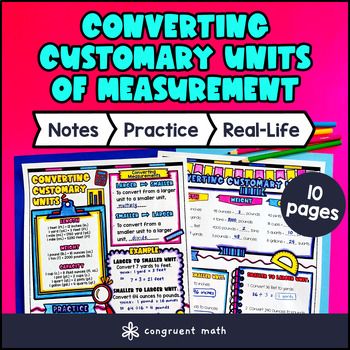Want more ideas and freebies?
Get my free resource library with digital & print activities—plus tips over email.
Join for Free Resources →
$4.25
Ever wondered how to teach customary units of measurement conversions in an engaging way to your 5th-grade students?
In this lesson plan, students will learn about converting customary units of measurements and their real-life applications. Through artistic, interactive guided notes, check for understanding, practice with a doodle & color by number activity, and a maze worksheet, students will gain a comprehensive understanding of measurement conversions.
The lesson ends with a real-life example that explores how converting customary units of measurements is used in practical scenarios, making the math skill relatable and applicable to students' daily lives.

$4.25
After this lesson, students will be able to:
Before this lesson, students should be familiar with:
As a hook, ask students why understanding customary units of measurement conversions is important in everyday life. Refer to the last page of the guided notes as well as the FAQs below for ideas.
Use the first page of the guided notes to introduce the concept of converting customary units of measurements. Go through how converting from larger to smaller units of measurements vs. converting from smaller to larger units of measurements. Walk through the key points such as identifying common customary units (inches, feet, yards, miles, cups, pints, quarts, gallons, ounces, pounds, etc.) and the relationships between them. Students will be filling out the guided notes as you teach.
Then, have students practice some of the conversions using the second page of the guided notes. Based on student responses, reteach concepts that students need extra help with regarding the initial introduction to customary units of measurements. If your class has a wide range of proficiency levels, you can pull out students for reteaching, and have more advanced students begin work on the practice exercises.
Have students practice converting customary units of measurement using the practice worksheet provided in the resource, such as escape the maze (pg. 3). Walk around to answer student questions.
Fast finishers can dive into the color by number activity (pg. 4) for extra practice. You can assign it as homework for the remainder of the class.
Using the last page of the guided notes, bring the class back together, and introduce the concept of applying customary units of measurement conversions in real-life scenarios such as cooking, determining distances on road trips, or converting measurements in DIY projects. Refer to the FAQ for more ideas on how to teach it!
If you’re looking for digital practice for converting customary units of measurement, try my Pixel Art activities in Google Sheets. Every answer is automatically checked, and correct answers unlock parts of a mystery picture. It’s incredibly fun, and a powerful tool for differentiation.
Here’s 1 activity to explore:
Customary units of measurements are the units commonly used for measuring length, weight, and capacity in the United States.
To convert between different customary units of measurements, you can use conversion factors. Here's how:
Learning to convert customary units of measurements is important because it allows for consistency and accuracy when comparing measurements in different units.
Sure! Here are some examples of converting customary units of measurements:
Common mistakes to avoid when converting customary units of measurements include:
Converting customary units of measurements is important in everyday life for tasks like cooking, DIY projects, and understanding product labels.
Products are often sold in various units, such as pounds and ounces for produce. Converting these units helps compare prices and quantities to make cost-effective purchasing decisions.
Get my free resource library with digital & print activities—plus tips over email.
Join for Free Resources →